21 Best Knee Strengthening Exercises And Precautions To Take
Work on your knees with exercises that strengthen your muscles, joints, cartilage, and bones.

Image: ShutterStock
Knee strengthening exercises are best for improving range of motion, reducing pain, and recovering from an injury.
About 25% of adults complain about knee pain, and its prevalence has increased by approximately 65% over the past 20 years (1). Knee pain may be caused due to obesity, injury, poor posture, torn ligamentsi A band of fibrous connective tissue located around your joints that connects the bones together . , arthritis, overuse, lack of rest, or not warming up or cooling before and after exercise.
You must not ignore knee pain. Resting and icing can work. However, after getting your doctor’s permission, you must start knee strengthening exercises to heal your knee faster. These exercises help improve flexibility and stability, promoting long-term knee health in addition to increasing physical strength. It’s important to do a range of exercises that focus on various knee muscle groups to avoid further injuries. Read on to learn more about the knee strengthening exercises that are best for you, how you can perform these exercises, and the precautions you must take.
 Knee Strengthening Exercises
Knee Strengthening Exercises- Frequency: 2-3 times per week.
- Benefits: Improve knee stability and reduce knee pain.
- Equipment Needed: Resistance bands, dumbbells, chairs, exercise mat.
- Space Required: Small area
- Assistance Required: Yes, for certain exercises
- Who Should Avoid: People with osteoporosis and osteoarthritis and anyone who has undergone knee surgery recently.
In This Article
Benefits Of Knee Strengthening Exercises
Knee-strengthening exercises offer a range of benefits that contribute to overall joint health and functionality, such as:
- Improves knee function
- Reduces pain
- Fortifies knee muscles
- Enhances stability and balance
- Aids in injury prevention
Now that you understand the benefits of knee strengthening exercises, explore some of the best exercises you can incorporate into your routine to achieve these positive outcomes. Scroll down to know more.
Key Takeaways
- Knee injuries can occur due to obesity, accidents, improper posture, and not warming up before exercising, among other issues.
- Increase knee mobility and strength with exercises that target the quadriceps, hamstrings, and calf muscles like quad crunches, knee marching, and straight leg raises.
- Begin the workouts with low intensity exercises and then gradually amp it up to prevent any pain or injury.
- It’s essential to stretch both before and after exercise to avoid knee muscle damage and pain.
21 Safe Knee Strengthening Exercises
Since your knee is supported by muscles, cartilagei A flexible connective tissue that differs from a bone in several ways and protects your bones and joints. , bones, ligaments, and fluids, you need to work on your quadriceps (front of your thighs), hamstrings (back of your thighs), shins (front of your legs), calves (back of your legs) and glutes (hip muscles) and do knee balancing and muscle relaxing exercises to help heal your knees. First, start by warming up. Here’s what you should do.
Warm Up
This is the most important step and should never be avoided before any workout routine, especially if you are trying to recover from an injury. Not warming up can aggravate the injury. Check this video about 1 minute warm-up for treating knee pain.
Learn how to strengthen your knees with these 4 easy exercises. Watch this video to get ready to feel stronger and more stable in no time.
Now, let’s start doing knee rehabilitation exercises.
1. Quad Clenches (Static Quads)
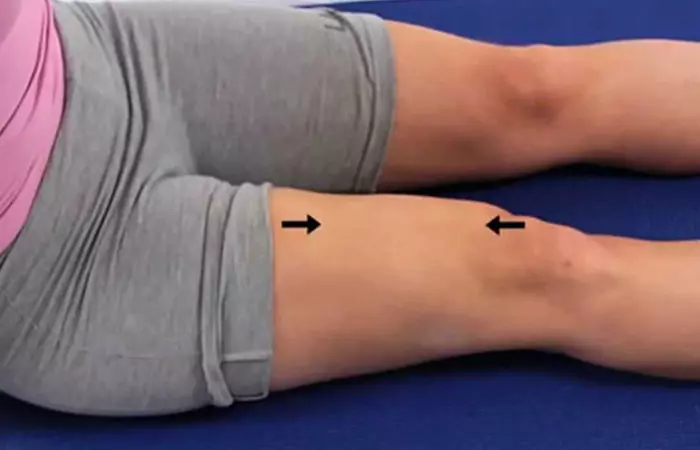
Target
As the name suggests, quad clenches target your quadriceps (muscles found in the front of your thighs) and is often recommended as a part of ACL injury prevention exercises since it is perfect for the initial stages of injury recovery.
Starting Position
Lie flat on your back with the legs and knees straight.
Steps To Do
- Tighten your quadriceps by clenching the muscles and ligaments joined to the knees. You can see and feel the front part of your knees move up when you clench your quadriceps.
- Hold for 2 seconds and then release.
Repetitions
Do this 10-20 times, every 3-4 hours.
Variation
If your knees hurt and you cannot straighten them fully, keep a rolled towel underneath your ankles to raise your legs slightly up. Do the exercise gently and slowly.
Precaution
Do not forcefully straighten your legs and avoid overdoing this exercise.
2. Knee Marching

Target
Quadriceps strengthening exercises like knee marching is also good during the initial stages of recovery. It helps to strengthen the quadriceps without putting any stress on the knee.
Starting Position
Sit on a chair with your feet flat on the ground.
Steps To Do
- Lift your left foot up. Hold for a fraction of a second and then lower your left leg to touch the ground.
- Now, lift your right leg up, hold for a fraction of a second, and lower your right leg to touch the ground.
Repetitions
Do this for a minute, twice a day.
Variation
As you recover from about 80% of your injury, you can add weights and do this exercise.
Precaution
Do not stomp your feet.
3. Straight Leg Raise
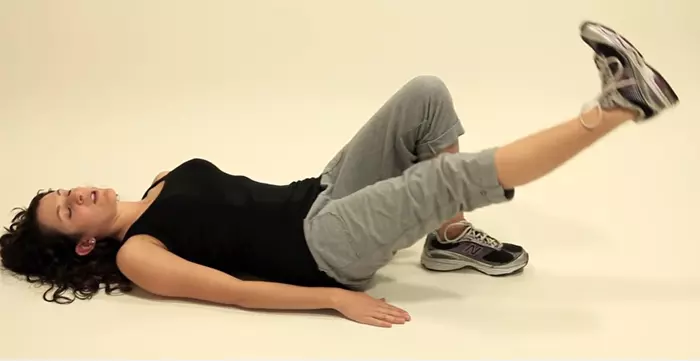
Target
The straight leg raise helps strengthen the quadriceps without putting weight on your knees.
Starting Position
Lie flat on your back. Keep one leg straight, bend the other leg and put your foot flat on the ground.
Steps To Do
- Pull the toes of the straight leg towards you.
- Clench the quadriceps of the straight leg and raise your leg about 6 feet off the floor.
- Hold for 2 seconds. Slowly lower the leg and release your quadriceps.
Repetitions
Repeat 10-20 times, twice a day.
Variation
As your knee gets better, you can wear your training shoes to add weight to the exercise or try setu bhadasanana in yoga for knee strengthening.
Precaution
Keep your knee straight when you raise the leg up. Avoid this exercise if you have back injury or back pain.
4. Long Arcs (Dynamic Quads)
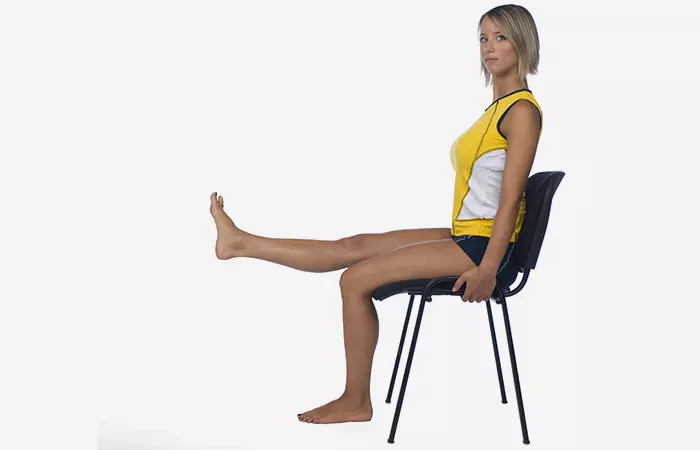
Target
Long arcs do not allow your knees to become stiff when you sit for more than 30 minutes at a stretch. They not only strengthen your quadriceps but are one of the easiest knee flexibility exercises you can include in your workout.
Starting Position
Sit on a chair with your feet flat on the floor.
Steps To Do
- Lift one foot up and straighten your leg.
- Hold for 3-5 seconds.
- Now, slowly flex your knee and lower your foot to the floor.
- Do this with your other leg.
Repetitions
Do this 10-20, times twice a day.
Variation
When your knees are about 80% recovered, you can add ankle weights.
Precaution
Do not keep your legs straight for too long, especially if the injury is recent.
5. Short Arcs (VMO Strengthening)
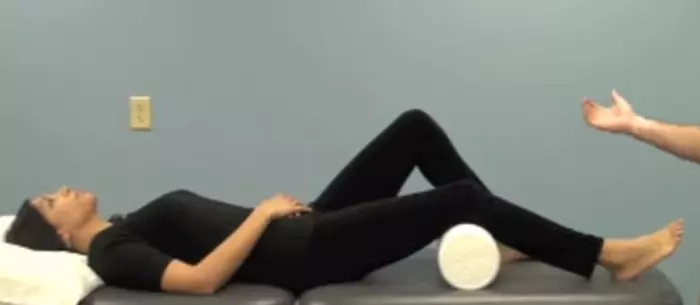
Target
Short arcs help improve knee strength and mobility. They also strengthen the quadriceps. Short arcs directly work on the vastus medialisi The innermost of the four quadriceps muscles (group of muscles at the front of the thigh) that extends to the knee. oblique muscles that help to control the position of the knee caps (patella).
Starting Position
Lie flat on your back and place a rolled towel underneath your knee.
Steps To Do
- Pull the toes towards yourself and clench your quadriceps.
- Now, lift your foot up until your knee is straight. Keep your knee resting on the towel.
- Hold for 3-5 seconds.
- Slowly lower your leg and release the clenched quadriceps.
Repetitions
Do this 10-20 times, twice a day.
Variation
You can do this exercise by lying flat on your back or adding ankle weights.
Precaution
Do not keep your leg up for more than 5 seconds as it may aggravate the injury.
 Quick Tip
Quick Tip6. Quadricep Stretch
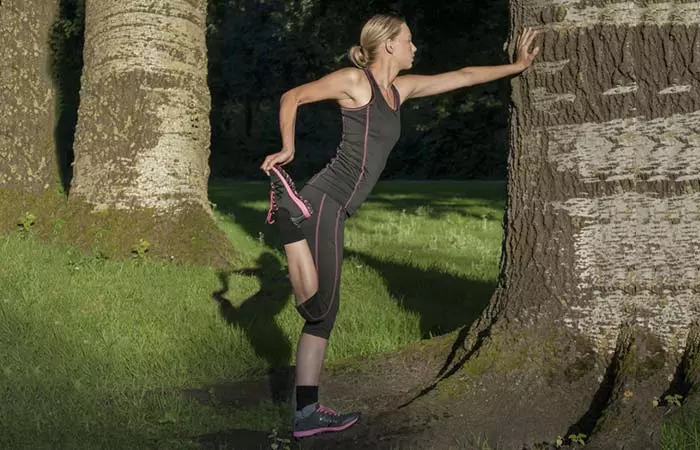
Target
As the name suggests, this exercise targets your quadriceps. The quadricep stretch is also known as the kick back. Balance exercises for knees strengthen and relax the quadriceps, which ultimately helps strengthen your knees. This is one of the best quad-strengthening exercises to improve overall leg stability.
Starting Position
Hold a chair and stand right behind it.
Steps To Do
- Lift your foot up and bring it towards your buttocks. Balance your body by keeping the other foot flat on the floor and holding the chair.
- Hold your foot and bring it closer to the body. You can feel the quadriceps stretch when you do this.
- Hold for 3-5 seconds and slowly release and lower your leg.
Repetitions
Do this 10 times, twice a day.
Variation
Instead of a chair, you can hold on to the wall.
Precaution
Do not overstretch and twist your body when you do the quadriceps stretch.
7. Hamstring Clenches
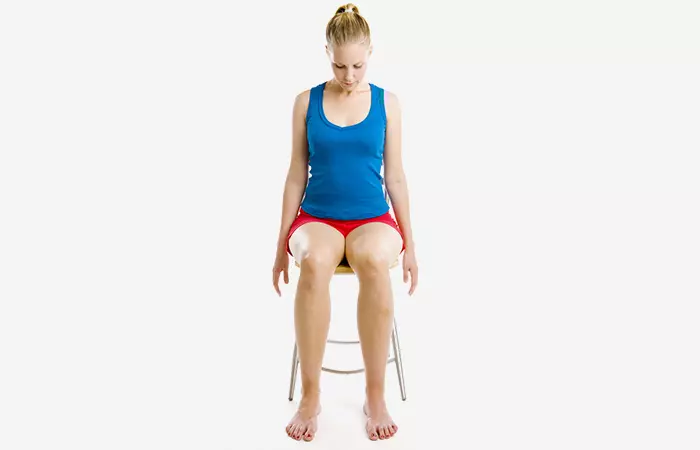
Target
The hamstrings are the muscles found at the back of your thighs. Since the hamstrings also help in knee and leg movement, strengthening them would take the load off the knees. This exercise will make your hamstrings strong and absorb the shock when you walk, run, or workout, causing less stress on the knee.
Starting Position
Sit on a chair with your feet flat on the floor, and your heels against the leg of the chair.
Steps To Do
- Press the heels against the leg of the chair firmly until you feel the back of your thighs clench.
- Hold for 5-10 seconds and then release.
Repetitions
You can do this exercise 10-20 times, twice a day.
Variation
There are no variations for this exercise.
Precaution
Do not move your feet while doing this exercise.
8. Hamstring Stretch

Target
The hamstring stretch can strengthen the knees and is among the most effective forms of patellofemoral pain syndrome exercises. It is stress-relieving and helps to strengthen the ligaments at the back of your knee and the hamstrings. It is also an excellent hamstring strengthening exercise to reduce leg pain.
Starting Position
Sit down on the floor with your hands and legs extended, and your palms facing the floor.
Steps To Do
- Slide towards your feet and feel the stretch in your hamstrings.
- Hold for 10-20 seconds and then slide back to the starting position.
Repetitions
Do this 5-10 times, twice a day.
Variation
You can do this exercise standing up, but you need not touch your toes with your fingertips. Stop when you feel the stretch.
Precaution
Do not lock your knees or try to touch your nose to your knees.
9. Hamstring Curls
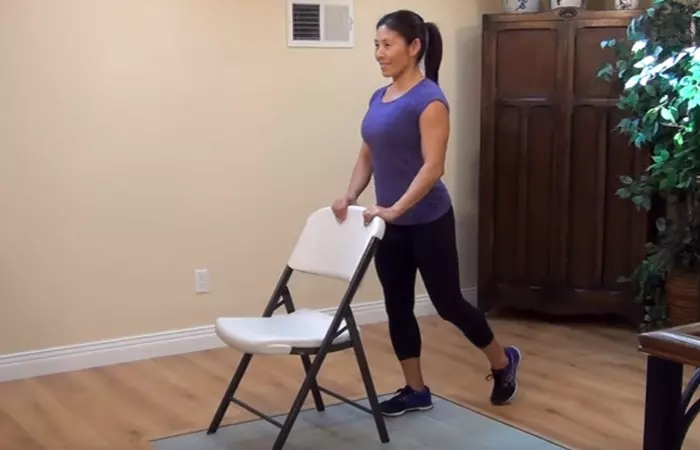
Target
Hamstring strengthening exercises like hamstring curls are similar to quadriceps stretch, but this exercise will strengthen your hamstrings instead of the quads and is one of the best joint mobility exercises that improve knee movement.
Starting Position
Hold a chair and stand straight with your foot flat on the floor.
Steps To Do
- Flex your knees and bring one foot up towards your buttocks.
- Hold for 2-3 seconds and then slowly lower your foot.
Repetitions
Do this 10-20 times, twice a day.
Variation
You can add ankle weight to the supporting leg.
Precaution
Do not bring your legs beyond 90 degrees or lock your knees.
10. Buttock Clenches (Glutes Isometric Exercise)

Target
Buttock clenches help strengthen your glutes or buttock muscles without moving the knees.
Starting Position
Lie down flat on your back with the legs straight, shoulders relaxed, and toes neutral.
Steps To Do
- Clench your buttocks. You can feel yourself rise a bit when you do so.
- Hold for 3 seconds and release your muscles.
Repetitions
You can do this 20 times, twice a day.
Variation
You may do the buttock clenches sitting on a chair.
Precaution
Do not move your body while you are doing this exercise.
11. Buttock Kicks
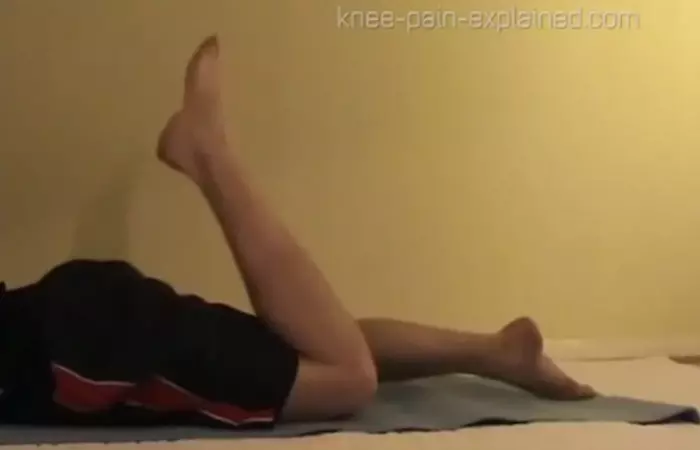
Target
This fun exercise helps to strengthen the knees without putting any stress on them. It helps to improve circulation and flexibility of the knees.
Starting Position
Lie flat on your tummy with the legs extended, toes flexed and touching the floor to support the legs, yours arms folded, and the palms underneath your chin.
Steps To Do
- Lift your feet up, flex your knees, and bring them close your buttocks.
- Hold for 2 seconds and then slowly lower them.
Repetitions
Do this 10 times, thrice a day.
Variation
You can add ankle weights after a week of doing this exercise.
Precaution
If you have a recent knee injury, place a soft towel underneath your knees.
12. Calf Raise
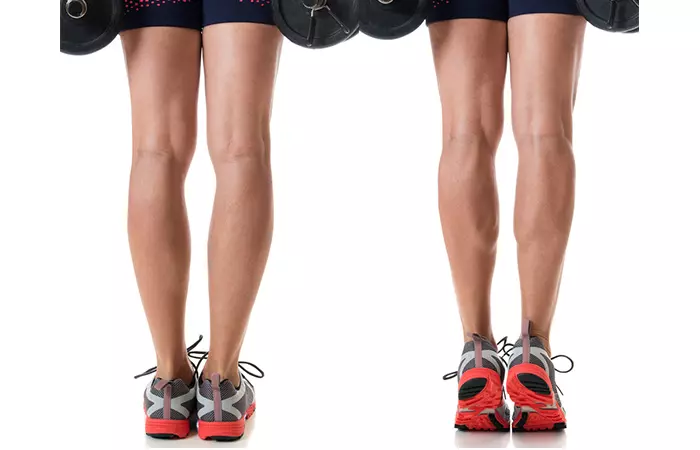
Target
The calf muscles are found at the back of your shin bone from the knees to your ankles. Like the quads and the hamstrings, the calf muscles also help absorb the shock when you walk, run, and workout. So, to strengthen your knees, you need to strengthen and relax your calf muscles.
Starting Position
Stand straight with your feet shoulder-width apart. If you want, you can hold the back of a chair for support.
Steps To Do
- Rise on your toes by lifting your heels as high as possible.
- Hold for 2 seconds and slowly lower your heels back to the starting position.
Repetitions
You can do this 10-20 times, twice a day.
Variation
You can sit on a chair and do this exercise.
Precaution
Do not over strain or overexercise.
13. Single Leg Dip
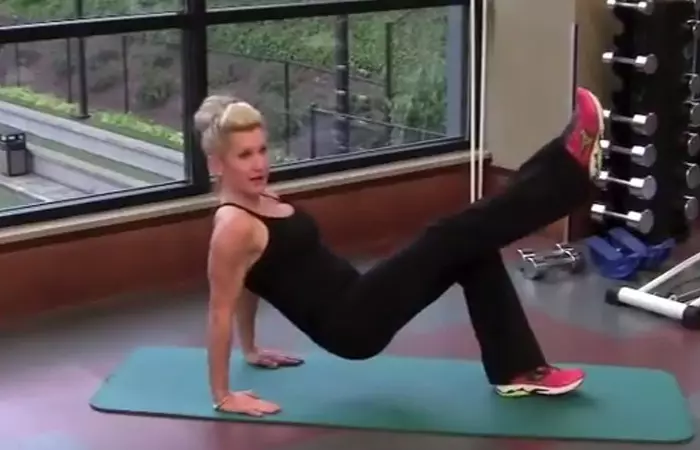
Target
The single leg dip targets the glutes, hamstrings, and quads. It strengthens these muscles, thereby strengthening the knees.
Starting Position
Sit on the floor with your knees flexed, feet flat on the floor. Support your upper body by placing your hands behind you, palms flat on the floor.
Steps To Do
- Lift your hips off the ground and straighten one leg. Support your body with the palms and one foot on the floor.
- Flex your elbows to lower your body till you feel the stretch.
- Hold for 2 seconds and then bring your body back to the starting position.
Repetitions
You can do this 10-15 times, once a day.
Variation
You can do the same exercise by supporting your upper body on a low-rise platform.
Precaution
Do not hold for too long or overstress yourself to do this exercise.
14. Knee Stabilization
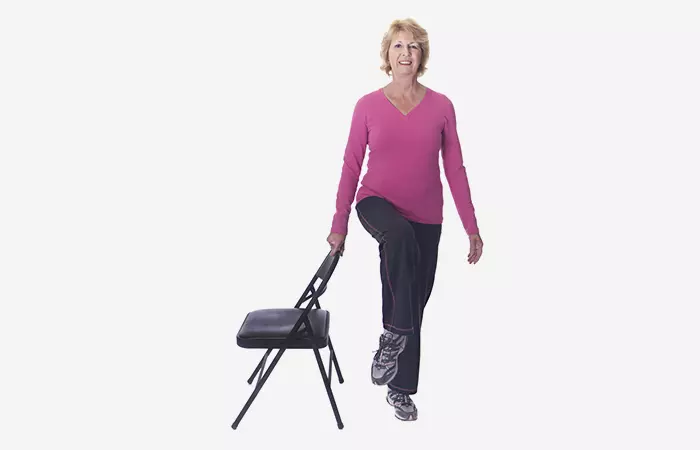
Target
Knee stabilization is a great way to strengthen your knees. It works on your outer and inner thighs, glutes, and hamstrings.
Starting Position
Hold a chair and stand right behind it with your feet flat on the floor.
Steps To Do
- Lift one foot off the floor and move your leg away from the supporting leg. Hold for 2 seconds.
- Move your leg in the opposite direction, i.e., towards your supporting leg.
- Move your leg back and hold for 2 seconds.
- Finally, move your leg forward and hold for 2 seconds.
Repetitions
Do this 10 times, twice a day.
Variation
You can hold a wall instead of a chair for support and move your legs in a circular motion, keeping your legs straight.
Precaution
Do not slouch or arch back while doing the exercise.
15. Wall Squat
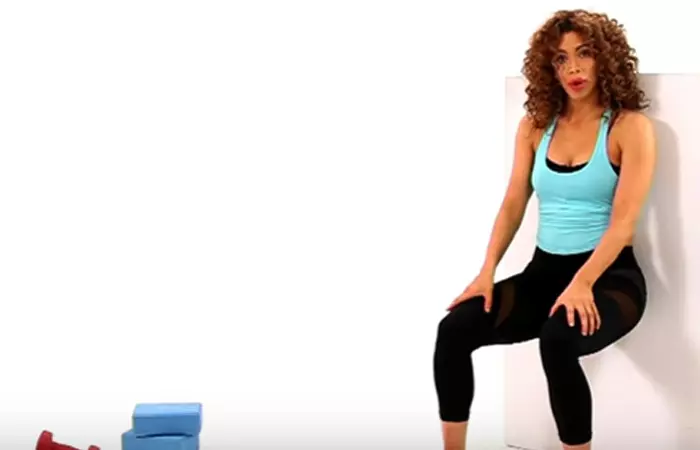
Target
Squatting right can help improve your knee strength and also reduce knee pain. Wall squats are the best to strengthen your knees as they work on all the muscles that are attached to the knee and help improve knee flexibility.
Starting Position
Position yourself against a wall, with your feet shoulder-width apart, and feet flat on the floor.
Steps To Do
- Flex your knees and lower your body, keeping your back and pelvis against the wall.
- Stop when your thighs are parallel to the floor.
- Hold for 2 seconds and then slowly rise.
Repetitions
Do this 10 times, twice a day.
Variation
If you feel comfortable enough, you can do this exercise without the support of a wall.
Precaution
Do not squat incorrectly, slouch, or arch back to prevent injuring your knees.
16. Amosov Squat
Target
If you have suffered a recent knee injury, the Amosov squat can be really helpful in strengthening your knees. In fact, it helps heal patellar tendonitisi A condition characterized by inflammation of the fibrous cords that attach your muscles to bones. faster. You place your weight on an immobile object and squat. This helps strengthen your quads, hamstrings, calves, and glutes.
Starting Position
Hold a sturdy immobile object with your feet flat on the floor and a little more apart than the width of your hips.
Steps To Do
- Flex your knees and keep your shins straight. Lower your body slowly and sit down completely without touching your hips to the floor. Make sure your feet are flat on the ground.
- Hold for two seconds and then slowly rise to the starting position.
Repetitions
Do this 10-20 times, twice a day.
Variation
There is no variation to this exercise.
Precaution
Lower your body cautiously and slowly to avoid knee injury.
17. Soleus Dynamic Squat Stretch
Target
This exercise is similar to the Amosov squat, and it helps improve the flexibility of the knees and strengthen the supporting muscles and ligaments.
Starting Position
Hold a sturdy waist-high object with the legs hips-width apart and feet flat on the floor.
Steps To Do
Flex your knees and slowly lower your body until your thighs are parallel to the floor.
Hold for 2 seconds and gently rise to the starting position.
Repetitions
Do this 10-20 times, twice a day.
Variation
No variations to this exercise.
Precaution
Do not raise your legs on your toes. Keep your heels fixed to the ground.
18. The Bridge
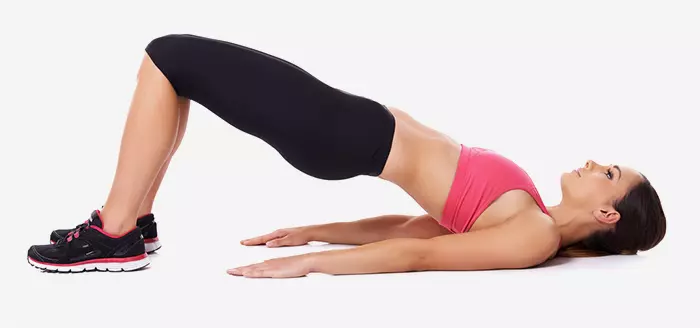
Target
This exercise works on the hamstrings, quads, and glutes. The bridge is an excellent exercise to strengthen your knees.
Starting Position
Lie down on your back with your knees bent, arms on the side, palms facing down, and feet flat on the floor.
Steps To Do
- Clench your buttocks and lift your hips about 3 inches off the floor. Your palms must be fixed flat on the floor.
- Hold for 2-3 seconds.
- Exhale and gently lower your body and come back to the starting position.
Repetitions
Do this 10-20 times, twice a day.
Variation
You can hold 2-pound dumbbells and place your hands on your tummy and do this exercise.
 Did You Know?
Did You Know?Precaution
Keep your back straight when you do this exercise.
19. Lunges
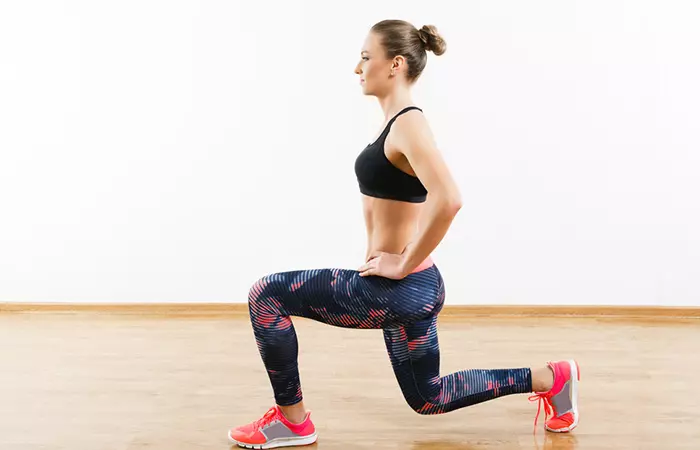
Target
Lunges work your quads, hamstrings, glutes, inner thighs, and calves. The strength of these muscles decides the strength of the knees. The stronger they are, the more shock they will absorb, thereby preventing knee injury and pain.
Starting Position
Stand straight with your legs hips-width apart, and hands resting on your waist.
Steps To Do
- Put your right leg forward, flex your knees, and lower your body.
- Hold for 2 seconds. Rise and go back to the starting position.
- Put your left leg forward, flex your knees, and lower your body.
- Hold for 2 seconds. Rise and go back to the starting position.
Repetitions
Do this 10-20 times, 2-3 times a day.
Variation
You can hold 2-pound weights in both your hands and do this exercise after two weeks of knee strengthening exercises.
Precaution
Do not do this exercise hastily. Also, avoid doing explosive lunges if your knee injury is recent.
20. Foam Roller Exercises
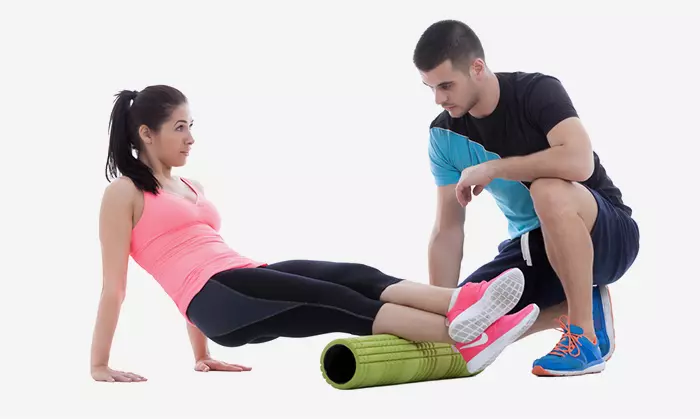
Target
Foam roller exercises are a great way to massage and relax your tight, inflamed, and contracted muscles. They are the best when it comes to treating mild knee injuries.
Starting Position
Sit on the floor with your legs extended, hands behind your back, and palms flat on the floor. Keep a foam roller underneath your thighs.
Steps To Do
- Lift your hips and move your body forward so that the foam roller rolls up your thighs.
- Move your body backward so that the foam roller rolls down.
- Place the foam roller underneath your calves and move your body up and down to roll the foam roller up and down your calf muscles.
- Lie on your side and place the foam roller underneath your thighs. Support your upper body by extending one hand and touching the floor with the fingertips.
- Move your body up and down so that the roller rolls down and up, massaging your outer thighs.
Repetitions
Do this series 5-10 times, twice a day.
Variation
No variations.
Precaution
Make sure not to over massage your body as that can aggravate the injury and inflammation. Click here to understand how to relieve full body pain with foam roller exercises.
21. Clamshells Exercise
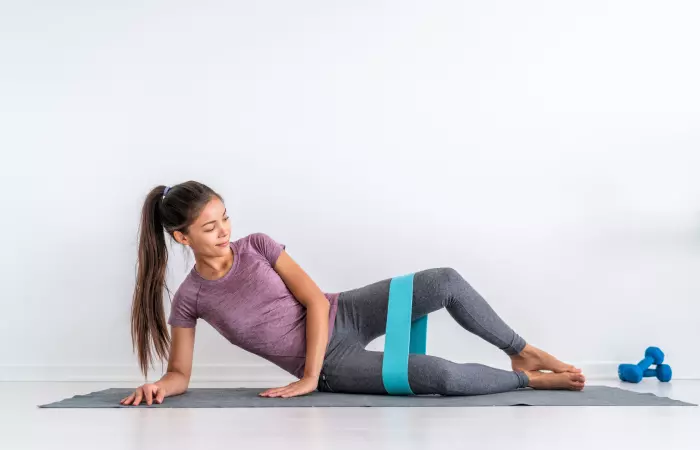
Target
This exercise specifically helps strengthen the muscles of the outer thighs, gluteus medius, and minimus to provide additional support and strength to the knees.
Starting Position
Lie on your side on a comfortable surface or exercise mat and make sure your spine, hips, and head are in a straight line.
Steps To Do
- Bend your knees at a 45-degree angle, keeping your feet together.
- Rest your head on your lower arm and tighten your abs by pulling your belly button in to stabilize your core and pelvis.
- Lift your upper knee as high as possible without moving your hip and pelvis.
- Hold briefly, then return your upper leg to the starting position.
Repetitions
Do 2 sets of 15-20 repetitions with each leg.
Variation
You can use a resistance band around your thighs to increase the difficulty level.
Precaution
Focus on proper form and perform this exercise in a slow and controlled way to avoid straining your back and neck.
Consistency is essential for visible improvements in knee strength and flexibility. Try to include knee strengthening exercises at least two to three times a week in your program. Regular practice helps maintain long-term knee health, making your workouts more effective but also helps you manage discomfort and avoid injuries.
There are tips you can follow along with these exercises to support your knees.Sylvie, a blogger, shares the steps she took to help support and strengthen her knees to manage the pain she felt in them. She writes, “For a while, my normal life came to a halt as I had to refocus my energy and attention on the stubborn pain, difficulty in walking- I couldn’t comfortably walk downstairs, hospital visits and a stop to exercise among other frustrations (i).” She recommends wearing the eight shoes and keeping your posture in check while performing these exercises, watching your diet, and stretching after exercising. She adds that it’s important to check how strong your knees are and whether they can support your weight before exercising.
While knee-strengthening exercises can support joint health and mobility, knowing when to seek professional guidance can help prevent potential issues. Scroll down to know more.
When To Seek Professional Help
Even though knee strengthening exercises can be helpful, it is important to consult a doctor if you have severe knee pain, swelling, or instability. A physiotherapist may offer exercises and advice that are specific to each patient’s requirements, ensuring a safe and efficient knee care regimen. Additionally, it’s essential to speak with a specialist before beginning a new routine if you have a history of knee injuries or surgery and experience persistent pain or discomfort when completing specific exercises.
Infographic: 5 Knee Rehabilitation Exercises To Reduce Knee Pain
Knee pain may be caused due to knee injury or torn ligaments, obesity, poor posture, overuse, and lack of rest. While resting may help reduce the pain, you can also perform some rehabilitation exercises to heal your knees faster. These exercises strengthen your knees, improve their range of motion, and help alleviate pain and recover from an injury. Check out the infographic below for the exercises.

Illustration: StyleCraze Design Team
Knee strengthening exercises not only help reduce pain and improve range of motion but also help avoid falls and injuries. While they may seem essential as you age, you can include them in your daily routine to help keep your knees strong and fully functional over time. Pilates for knee strengthening also helps in improving mobility and you can also try cycling for knee health. Moreover, incorporating low-impact cardio exercises for bad knees can also be beneficial for strengthening the knees. However, following proper warm up and cool down stretches while not overdoing the reps, is important in not straining your knees. Include the above-mentioned range-of-motion exercises for knees in your daily routine to keep them feeling free, flexible, strong, and active.
Frequently Asked Questions
What are some effective warm-up exercises for knee health?
Leg swings, knee lifts, and dynamic lunges serve as excellent warm-up exercises for knee health because they improve joint flexibility and blood flow. Stretches like the hamstring and quadriceps stretches may get the muscles surrounding the knee ready for action and lower the chance of injury.
Why do my knees crack when I squat?
It is because of the body weight pressure. It is normal if not associated with pain or swelling.
What are weak knees a symptom of?
Weak knees could indicate arthritis, sprain, strain, torn ligaments, or injuries.
Does walking strengthen your knees?
Yes, walking is a low-impact exercise that helps strengthen your knees and improve their range of motion.
What exercises should I avoid with knee pain?
You should avoid high-impact exercises and movements as in jumping, running, or kickboxing. Also, avoid any exercise and activity that puts too much pressure and stress on your knees.
Personal Experience: Source
StyleCraze's articles are interwoven with authentic personal narratives that provide depth and resonance to our content. Below are the sources of the personal accounts referenced in this article.
i. Knee Pain and Exercise-The Mistakeshttps://sylvieamayo.medium.com/knee-pain-and-exercise-the-mistakes-a529ae300020
References
Articles on StyleCraze are backed by verified information from peer-reviewed and academic research papers, reputed organizations, research institutions, and medical associations to ensure accuracy and relevance. Read our editorial policy to learn more.
- Knee Pain in Adults and Adolescents: The Initial Evaluation
https://pubmed.ncbi.nlm.nih.gov/30325638/
Read full bio of Dr. Sudhansu Singh
Read full bio of Ravi Teja Tadimalla
Read full bio of Payal Karnik







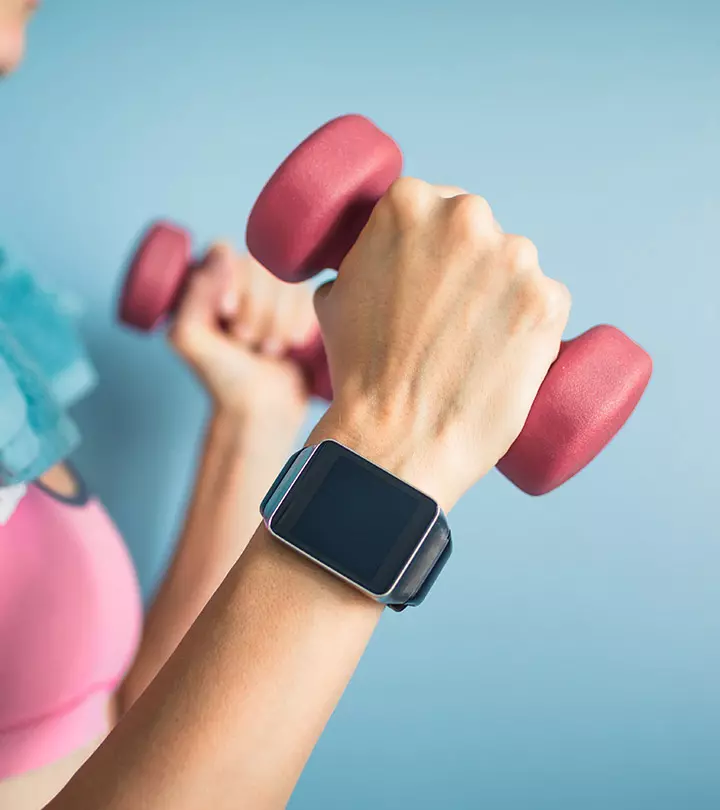



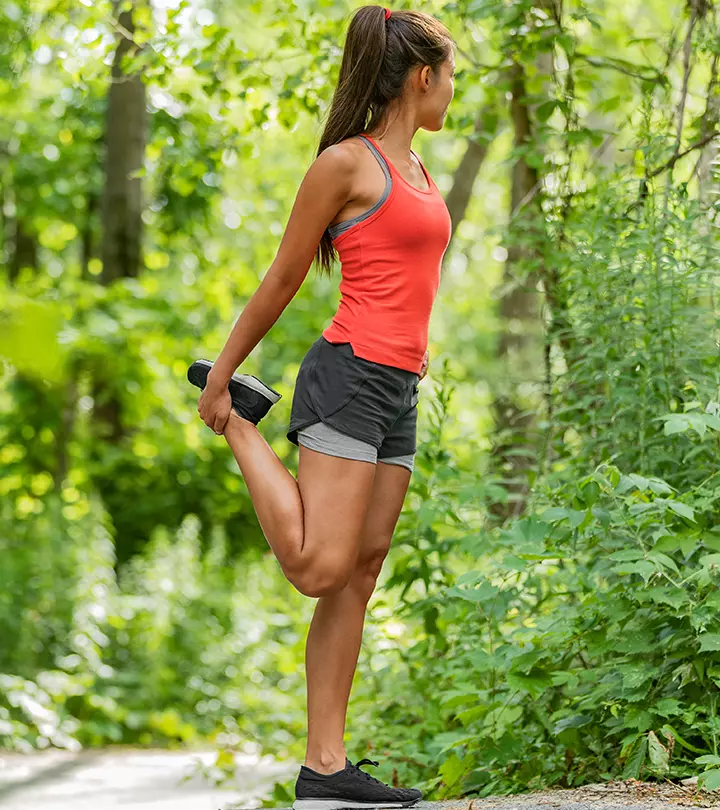

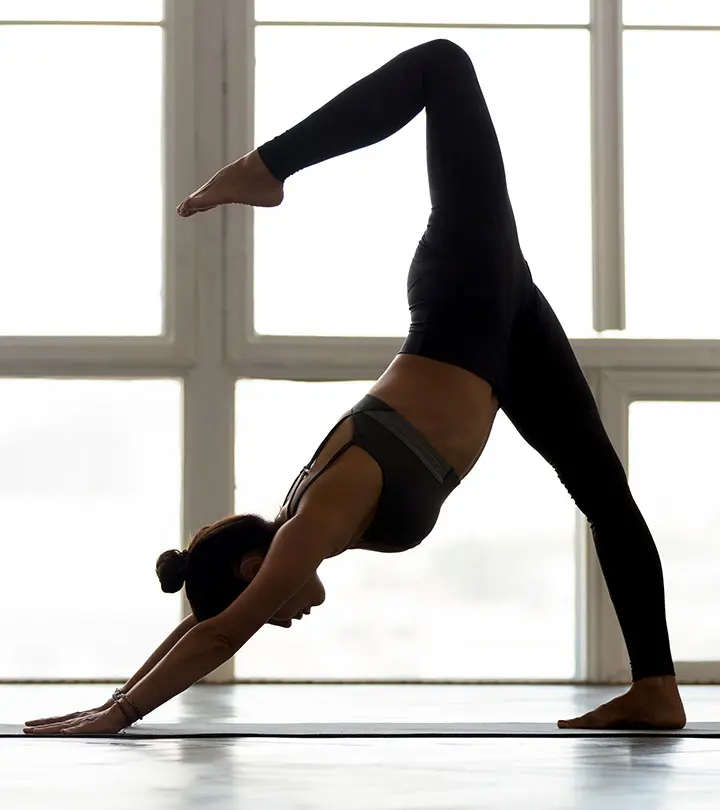
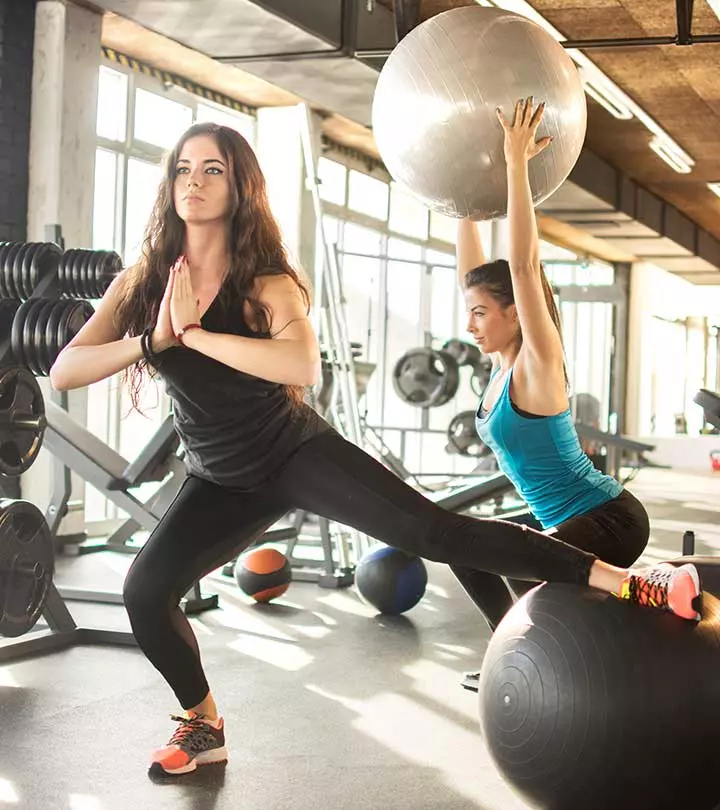
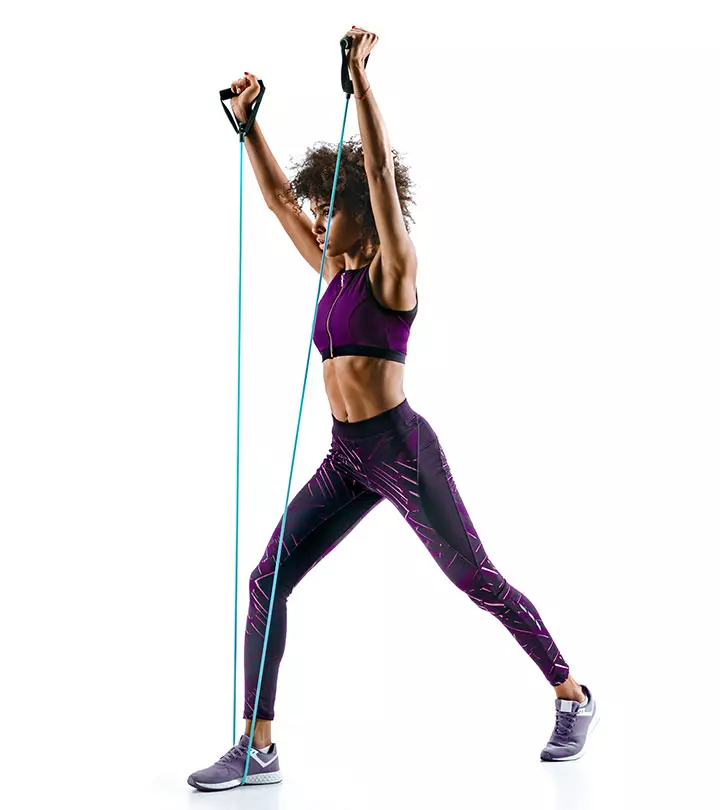
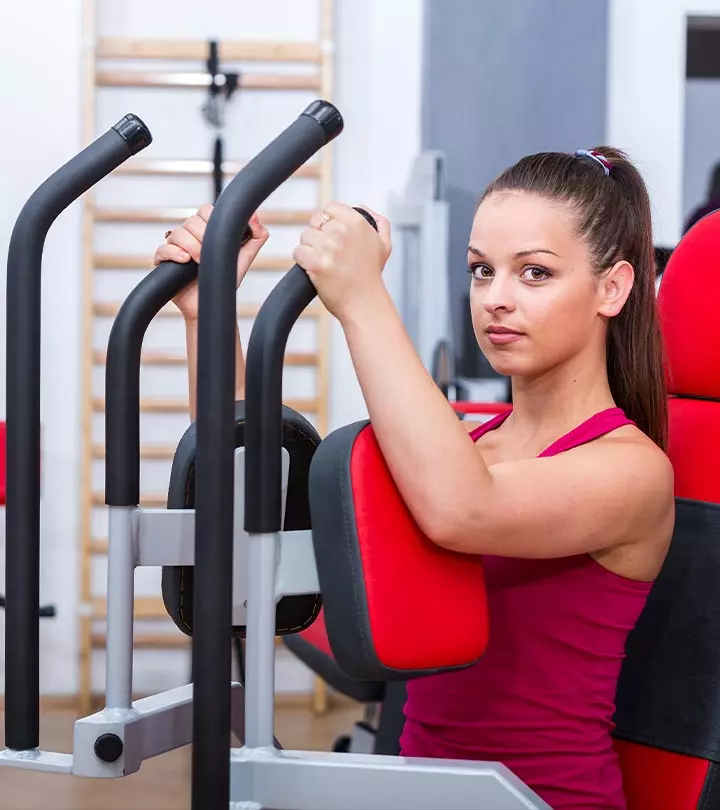
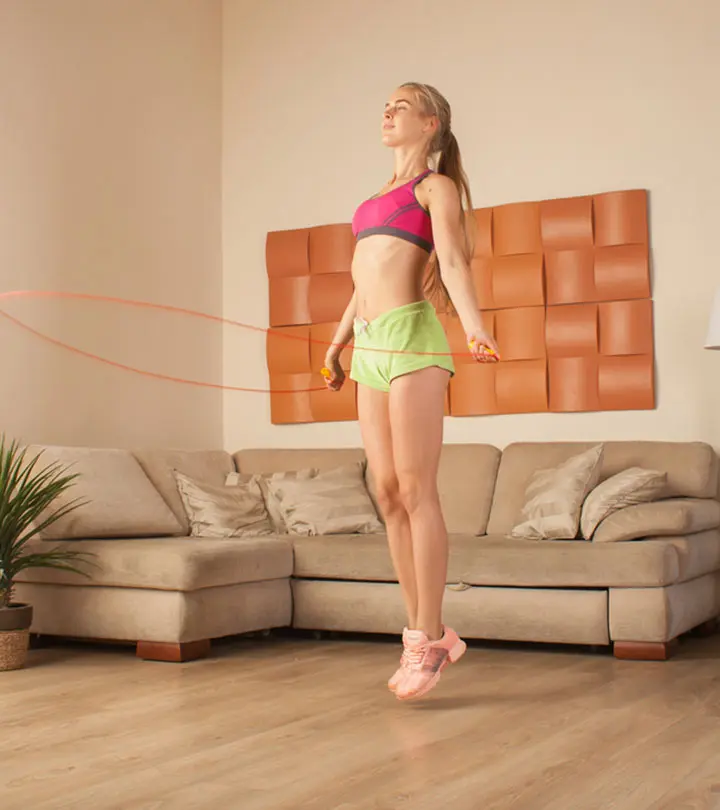


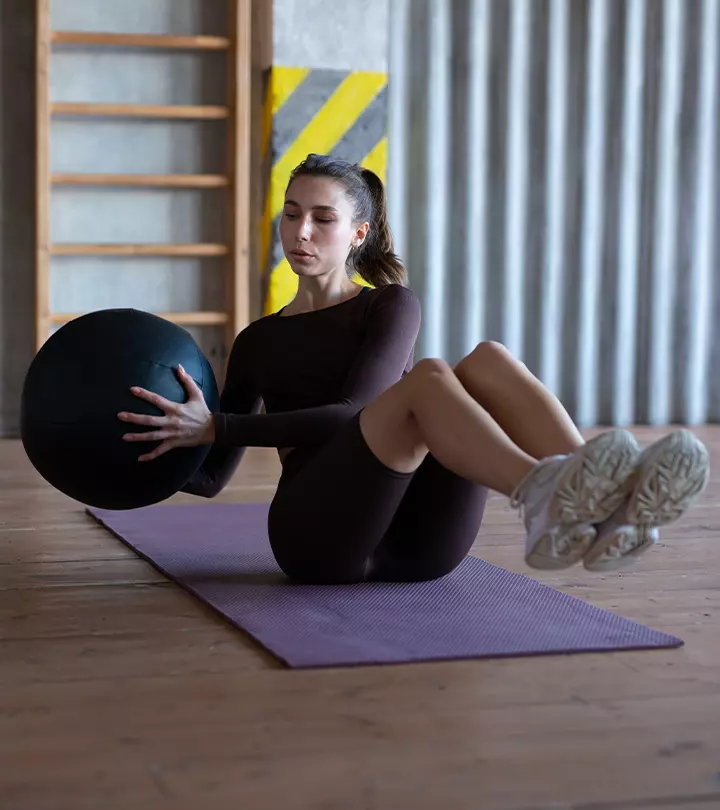
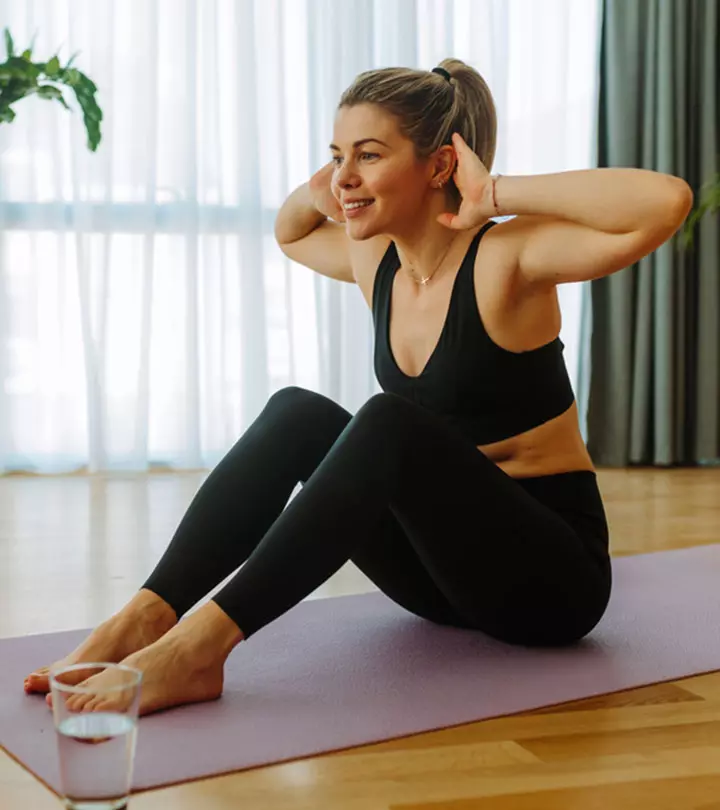

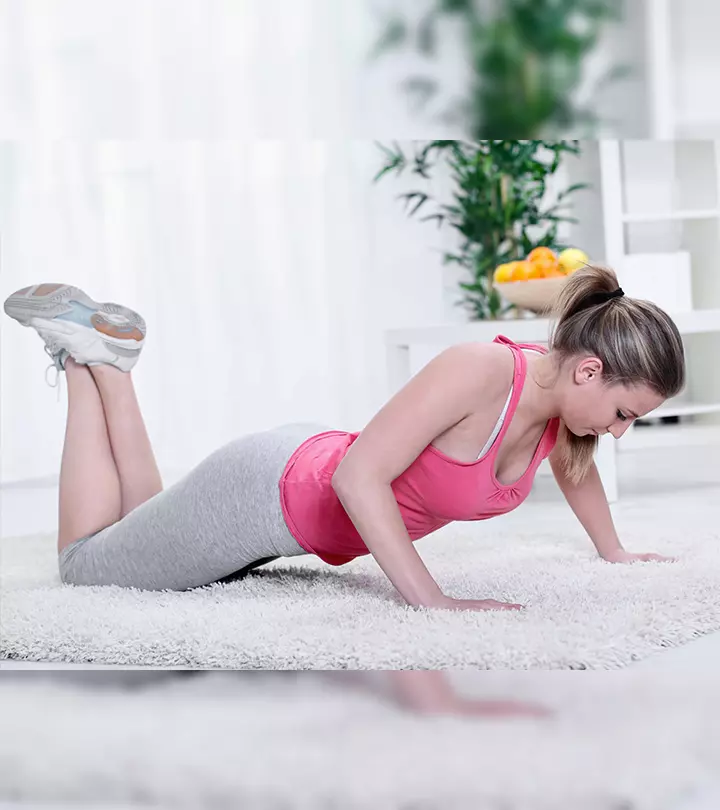
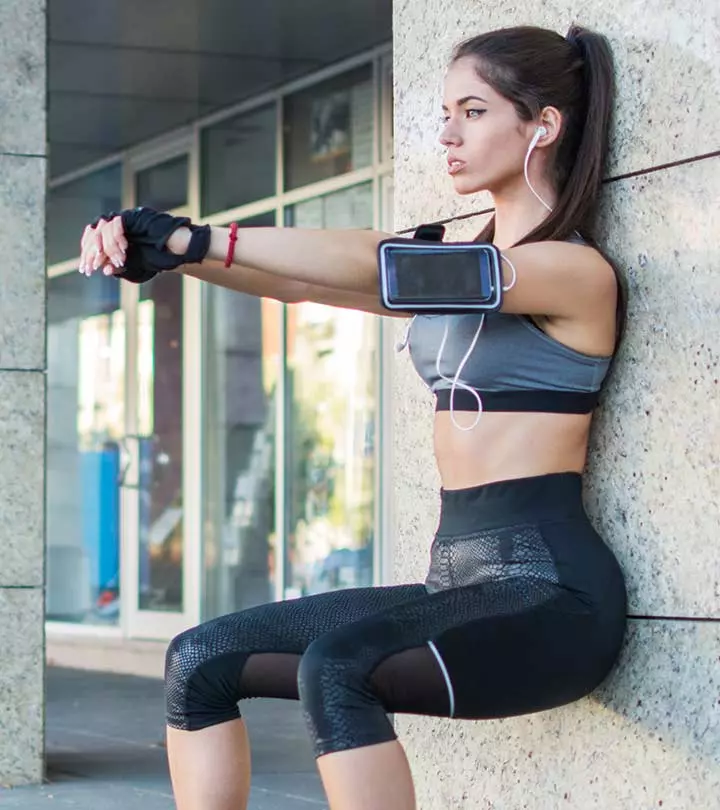

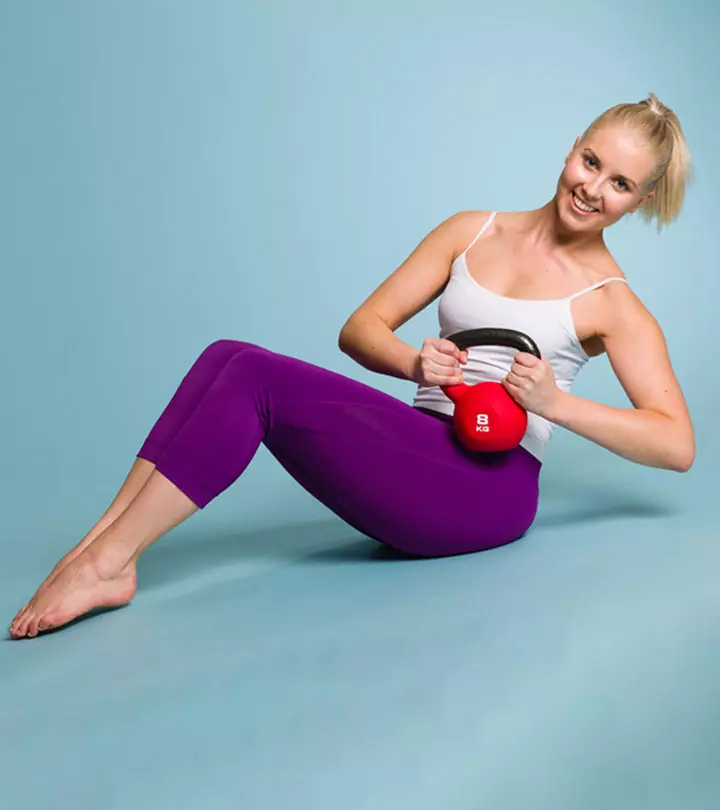

Community Experiences
Join the conversation and become a part of our empowering community! Share your stories, experiences, and insights to connect with other beauty, lifestyle, and health enthusiasts.